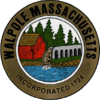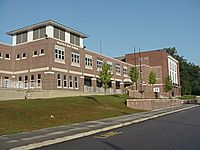Walpole, Massachusetts facts for kids
Quick facts for kids
Walpole
|
||
|---|---|---|
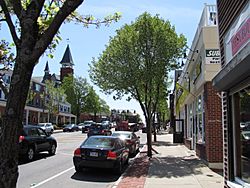
Main Street
|
||
|
||
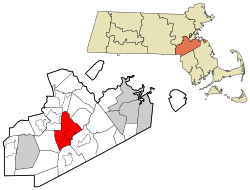
Location in Norfolk County in Massachusetts
|
||
| Country | United States | |
| State | Massachusetts | |
| County | Norfolk | |
| Settled | 1659 | |
| Incorporated | 1724 | |
| Named for | Robert Walpole | |
| Government | ||
| • Type | Representative town meeting | |
| Area | ||
| • Total | 21.0 sq mi (54.4 km2) | |
| • Land | 20.5 sq mi (53.2 km2) | |
| • Water | 0.5 sq mi (1.2 km2) | |
| Elevation | 150 ft (46 m) | |
| Population
(2020)
|
||
| • Total | 26,383 | |
| • Density | 1,287.0/sq mi (495.9/km2) | |
| Time zone | UTC−5 (Eastern) | |
| • Summer (DST) | UTC−4 (Eastern) | |
| ZIP code |
02081 or 02032 or 02071
|
|
| Area code(s) | 508 / 774 | |
| FIPS code | 25-72495 | |
| GNIS feature ID | 0618331 | |
| Website | www.walpole-ma.gov | |
Walpole is a town in Norfolk County, Massachusetts, United States. It's about 18 miles (29 km) south of downtown Boston and 30 miles (48 km) north of Providence, Rhode Island. In 2020, about 26,383 people lived in Walpole.
Walpole was first settled in 1659. It was part of Dedham until 1724, when it officially became its own town. The town was named after Sir Robert Walpole, who was like the first Prime Minister of Great Britain.
Contents
History of Walpole
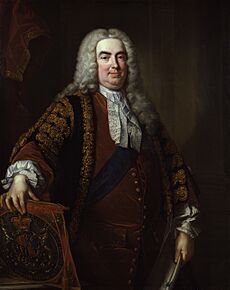
Walpole was originally land claimed by the Neponset band of the Massachusett Native American tribe. In 1635, the Neponset tribe officially claimed this area. The nearby town of Dedham wanted more land.
So, in 1636, Dedham made a deal with the Neponset tribe. Dedham gained land that now includes Walpole and several other towns like Norwood and Medfield. This land deal covered parts of 16 different towns today.
Early Industries and Town Creation
After Dedham bought the land, the saw mill industry started to grow in the area. The very first saw mill in Walpole was built near School Meadow Brook and the Neponset River. It was in the area that is now the Walpole Town Forest. Two wealthy men from Dedham, Joshua Fisher and Major Eleazer Lusher, owned this mill.
In 1717, people living in the outer parts of Dedham wanted to have their own church. They also wanted the school to move around town. But in 1721, the town of Dedham said no to them having their own church.
So, these residents asked again to become their own town. Other nearby areas joined them. Finally, with encouragement from the government, the new town of Walpole was created in May 1724. It was named after Sir Robert Walpole.
Walpole's Role in the American Revolution
Walpole played a part in the events leading up to the American Revolutionary War. The people of Walpole did not like the taxes the British government put on them. They sent a representative, Joshua Clapp, to meetings in Boston. These meetings were to discuss how Massachusetts would stay safe during the war.
In 1775, Walpole sent 157 men to the Battle of Lexington and Concord. Captain Seth Bullard led these men. Later, in December 1777, British ships came into Narragansett Bay in Rhode Island. Walpole sent two groups of minutemen, 65 men in total, to help. Joshua Clapp and Oliver Clapp led them. They stayed in Rhode Island for three weeks to help defend the port.
Growth and Development After the War
Walpole grew a lot after the Revolutionary War. By 1860, there were 1,935 people living there. Around this time, many mills were built, mostly along the Neponset River. These mills used the river's power to make things like cotton, lumber, and paper.
The most famous mill was the Bird Company in East Walpole. It was a very large complex. The company stopped working there in 1980. Most of the old buildings were torn down, and now houses are built there. The Neponset River was also used for transportation and as a water supply.
The Norfolk County railroad also connected Walpole to other towns. It was part of a larger railroad system that linked Walpole to Boston and New York City. Many churches were also started in Walpole during this time.
Walpole's first public library was started in 1872 by Miss Mary R. Bird. Before that, a group called "The Ladies' Literary, Moral Society" had a private library in 1816. They wanted to provide books that would "afford useful information to the mind and improvement to the heart."
Walpole in the 1900s
The town continued to grow a lot in the 1900s. By the 1920s, the population had increased by over 3,000 people. In 1922, a local resident named Maude R. Greeves talked about how much Walpole had changed. She mentioned the old saw mill on the town seal. She said Walpole was now a "thriving town" with 5,446 people.
The town seal was chosen in 1914. Edna Buck, a high school student, designed it and won $25. Her design was based on the ruins of an old saw mill on Brook Street.
In 1929, Harriet Nevins gave $50,000 to build a public building. It was a memorial for her parents, George and Nancy Blackburn. Her father had lived and worked in Walpole. This building, called Blackburn Memorial Building (or Blackburn Hall), was finished in 1932. It's a red brick building with whitewashed pillars. The town still owns it, and it's used for many activities, including children's theater. Harriet Nevins also left money for a fountain for horses and dogs. This fountain is still on School Street, across from Town Hall, but it no longer has water.
Population in Walpole
| Historical population | ||
|---|---|---|
| Year | Pop. | ±% |
| 1850 | 1,929 | — |
| 1860 | 2,037 | +5.6% |
| 1870 | 2,137 | +4.9% |
| 1880 | 2,494 | +16.7% |
| 1890 | 2,604 | +4.4% |
| 1900 | 3,572 | +37.2% |
| 1910 | 4,892 | +37.0% |
| 1920 | 5,446 | +11.3% |
| 1930 | 7,273 | +33.5% |
| 1940 | 7,443 | +2.3% |
| 1950 | 9,109 | +22.4% |
| 1960 | 14,068 | +54.4% |
| 1970 | 18,149 | +29.0% |
| 1980 | 18,859 | +3.9% |
| 1990 | 20,212 | +7.2% |
| 2000 | 22,824 | +12.9% |
| 2010 | 24,070 | +5.5% |
| 2020 | 26,383 | +9.6% |
| 2022* | 26,277 | −0.4% |
| * = population estimate. Source: United States Census records and Population Estimates Program data. |
||
In 2010, there were 24,070 people living in Walpole. About 35.4% of households had children under 18. Most households (63.2%) were married couples. The average household had 2.72 people.
The population was spread out by age. About 25.8% were under 18, and 14.4% were 65 or older. The average age was 39 years old.
Weather and Climate
Walpole has a humid continental climate. This means it has warm, humid summers and cold, snowy winters. This is typical for Massachusetts and New England.
The warmest month in Walpole is July. The average high temperature is about 83.4°F (28.6°C). The coldest month is January, with an average high of 36.8°F (2.7°C).
Walpole gets a lot of rain and snow throughout the year. On average, it receives about 49.59 inches (1259.6 mm) of rain each year. The town can also be affected by "Nor'easter" storms, which bring heavy snow or rain. Sometimes, hurricanes or tropical storms can reach the area in the fall.
| Climate data for Walpole, Massachusetts (WALPOLE 2), 1991–2020 normals | |||||||||||||
|---|---|---|---|---|---|---|---|---|---|---|---|---|---|
| Month | Jan | Feb | Mar | Apr | May | Jun | Jul | Aug | Sep | Oct | Nov | Dec | Year |
| Mean daily maximum °F (°C) | 36.8 (2.7) |
39.6 (4.2) |
47.4 (8.6) |
59.4 (15.2) |
69.9 (21.1) |
77.9 (25.5) |
83.4 (28.6) |
81.7 (27.6) |
74.1 (23.4) |
62.5 (16.9) |
51.4 (10.8) |
41.6 (5.3) |
60.5 (15.8) |
| Daily mean °F (°C) | 28.2 (−2.1) |
30.4 (−0.9) |
37.7 (3.2) |
48.5 (9.2) |
58.8 (14.9) |
67.6 (19.8) |
73.4 (23.0) |
71.8 (22.1) |
64.3 (17.9) |
52.6 (11.4) |
42.5 (5.8) |
33.5 (0.8) |
50.8 (10.4) |
| Mean daily minimum °F (°C) | 19.7 (−6.8) |
21.1 (−6.1) |
27.9 (−2.3) |
37.6 (3.1) |
47.7 (8.7) |
57.2 (14.0) |
63.3 (17.4) |
61.8 (16.6) |
54.4 (12.4) |
42.8 (6.0) |
33.6 (0.9) |
25.4 (−3.7) |
41.0 (5.0) |
| Average precipitation inches (mm) | 3.94 (100) |
3.36 (85) |
4.77 (121) |
4.43 (113) |
3.59 (91) |
4.25 (108) |
3.58 (91) |
3.95 (100) |
3.71 (94) |
4.97 (126) |
4.08 (104) |
4.96 (126) |
49.59 (1,260) |
| Average snowfall inches (cm) | 15.1 (38) |
14.1 (36) |
11.6 (29) |
2.5 (6.4) |
0 (0) |
0 (0) |
0 (0) |
0 (0) |
0 (0) |
0.3 (0.76) |
1.7 (4.3) |
10.8 (27) |
56.1 (142) |
| Source: NOAA | |||||||||||||
Education in Walpole
Walpole's public school system is managed by a school committee with seven members. This committee chooses a superintendent, who then picks the principals for each school. The current superintendent is Bridget Gough.
Walpole has seven public schools:
- Four elementary schools
- Two middle schools
- One high school
Elementary Schools
The four elementary schools are Old Post Road School, Elm Street School, Boyden School, and Fisher School.
- Old Post Road School is in East Walpole. It has about 500 students from kindergarten to fifth grade.
- Fisher School was the first school in Walpole, started in 1790 as a one-room schoolhouse. A modern building was built in 1914. In 2007, about 470 students attended.
- Boyden Elementary School was founded in 1854. It was closed for a few years and used as a special school. It reopened in 1990 and had about 460 students in 2010.
- Elm Street School is Walpole's newest school. It opened in 1999 and was updated in 2004. It has about 520 students.
Middle and Other Schools
- The middle schools in Walpole are Johnson Middle School and Bird Middle School.
- Blessed Sacrament is a private Catholic School in Walpole.
- Shishu Bharati School of Languages and Culture of India, a private school for Indian languages and culture, has a branch in Walpole.
- The town is also home to the Norfolk County Agricultural High School and the Longview Farm School.
State Prison Information
Part of a maximum security prison for men, called Massachusetts Correctional Institution – Cedar Junction, is located in Walpole. It was originally named "MCI—Walpole." However, residents of the town successfully asked for the name to be changed in the mid-1980s. This is because only part of the prison is in Walpole; another part is in the nearby town of Norfolk.
As of April 2022, Cedar Junction prison is planned to close within the next two years. This is happening because fewer people are being sent to prison, and the cost to keep the prison running is very high.
Recreation and Parks
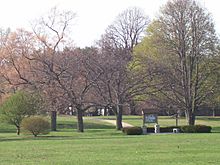
Francis William Bird Park is a large park, about 89 acres (36 hectares) in size. It is owned and cared for by The Trustees of Reservations. The park has over three miles (5 km) of paths for walking and biking. These paths go over streams using old granite bridges. They also pass through grassy meadows with large shade trees and ponds.
At the park, you can find bike racks, restrooms (open during certain seasons), a play area for children, four tennis courts, a basketball hoop, and an outdoor stage.
Bird Park was created in 1925 by Charles Sumner Bird, Sr., and his wife Anna. They made the park to remember their oldest son, Francis William Bird, who passed away in 1918. A landscape architect named John Nolen designed the park. He believed that parks were important for people's health and should offer a peaceful place in nature.
John Nolen wrote that this park should be:
...a quiet place to relax in the middle of East Walpole...with wide, sunny meadows, shady spots, and higher hills with trees for those who like shade, all with the sound of a small stream.
For many years, the park was managed by a special trust. Over time, some parts of the park were damaged or not cared for. In 2002, The Trustees of Reservations took over the park. Today, the park is in great condition. New ornamental trees like cherry and Japanese maple trees have been planted, along with flower beds.
Sports in Walpole
Walpole High School Athletics
Walpole High School has many successful sports teams:
- The football team has been ranked among the top 25 teams in the USA twice.
- The boys lacrosse team won the Division 2 State Championship in 2009.
- In 2004, both the boys and girls high school basketball teams won their Massachusetts State Titles on the same day.
- The boys cross country team has won Massachusetts Sectional Championships many times, including in 2014, 2018, and 2023.
- The boys hockey team made it to the Massachusetts High School Super 8 for the first time in 2017. They then won the Division 1 state championship in 2020.
Team Names: Timberwolves and Porkers
Most Walpole High School teams are called the Timberwolves. However, the girls field hockey team has a unique nickname: the Porkers. In 2023, the Porkers won their 13th State Championship. This win set a new record for the most championship titles in Massachusetts field hockey history.
Youth Sports Leagues
Walpole has many youth sports leagues. These leagues give young athletes different options throughout the year. Many are run through the Walpole Recreation Department.
- Walpole Little League has won the state championship twice, in 1991 and 2007. In 2007, they even went to the Little League World Series!
- The Walpole Express is a hockey organization for junior, youth, and girls teams based in Walpole.
Media and Local News
Walpole Community Television, started in 1984, broadcasts local programs for all Walpole cable TV subscribers.
Transportation and Geography
Walpole is surrounded by several towns:
- To the north: Dover
- To the northeast: Westwood, Canton, and Norwood
- To the east: Sharon
- To the south: Foxboro
- To the west: Norfolk and Medfield
Walpole has a train station, Walpole station, on the MBTA Commuter Rail Franklin/Foxboro Line. There is also an MBTA bus route (34E) that ends in downtown Walpole.
Notable People from Walpole
Many interesting people have connections to Walpole, including:
- Andrew Bacevich: A professor of international relations.
- Todd Collins: A professional American football quarterback.
- Gene Lavanchy: A TV news anchor for FOX channel 25 in Boston.
- Mary Lavin: An award-winning short story writer who was born in Walpole.
- Mike Milbury: A former Boston Bruins ice hockey player and coach.
- Joe Morgan: A professional baseball manager, including for the Boston Red Sox.
- George Arthur Plimpton: An American publisher and helper of good causes.
- Butch Songin: A quarterback for various football teams and an All-American ice hockey player.
- Roger Turner: An Olympic Figure Skater.
- Chris Wagner: An ice hockey player for the Boston Bruins.
- Joseph N. Welch: A special lawyer for the United States Army during the Army–McCarthy Hearings. He also acted in a movie.
Images for kids
See also
 In Spanish: Walpole (Massachusetts) para niños
In Spanish: Walpole (Massachusetts) para niños


